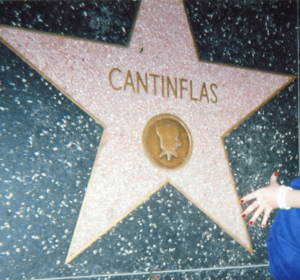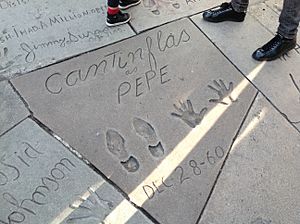Cantinflas facts for kids
Quick facts for kids
Cantinflas
|
|
|---|---|

Cantinflas in 1964
|
|
| Born |
Mario Fortino Alfonso Moreno Reyes
12 August 1911 Santa María la Redonda, Mexico City, Mexico
|
| Died | 20 April 1993 (aged 81) Mexico City, Mexico
|
| Burial place | Panteón Español, Mexico City, Mexico |
| Nationality | Mexican |
| Other names | Mario Moreno |
| Citizenship | Mexican |
| Education | Instituto Politecnico Nacional Chapingo Autonomous University (Agronomy, few months) |
| Occupation | Comedian, actor, screenwriter, film producer, singer |
| Years active | 1936–1984 |
| Political party | Institutional Revolutionary Party |
| Spouse(s) |
Valentina Ivanova Zubareff
(m. 1936; died 1966) |
| Children | Mario Arturo Moreno |
Mario Fortino Alfonso Moreno Reyes (born August 12, 1911 – died April 20, 1993) was a famous Mexican comedian, actor, and filmmaker. He was known by his stage name, Cantinflas. Many people consider him the most successful Mexican comedian ever. He is loved across Latin America and in Spain as a popular icon.
Cantinflas' humor was special because it used many unique Mexican Spanish words and ways of speaking. This made people in all Spanish-speaking countries love him. His style even created new words like cantinflear (to talk a lot without saying much) and cantinflada (a Cantinflas-like speech).
Even though some of his movies were translated into English and French, his clever wordplay was hard to translate. He often played characters who were poor farmers or simple people from the streets, called pelado. This character helped Cantinflas have a very long and successful film career, even in Hollywood. The famous comedian Charlie Chaplin once said that Cantinflas was the best comedian alive. People often called Moreno the "Charlie Chaplin of Mexico."
Many people around the world remember him for his role with David Niven in the Oscar-winning movie Around the World in 80 Days. For this movie, Moreno won a Golden Globe Award for Best Actor – Motion Picture Musical or Comedy.
Cantinflas was a leader in Mexican cinema and helped start its "golden era" (a time when Mexican movies were very popular and well-made). He also became involved in helping workers. His image as someone who spoke up for ordinary people made his actions important. He helped in the early fight against unfair practices that tried to control workers' unions.
His character, Cantinflas, became very famous. Experts in media, language, and philosophy studied him. They saw him in different ways: as a clever speaker, or a hero who always found a way to win, even when he was an underdog.
Contents
Early Life and Family
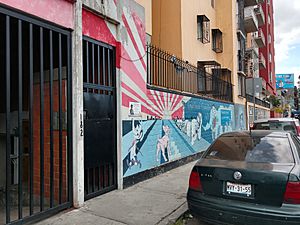
Mario Fortino Alfonso Moreno Reyes was born in the Santa María la Redonda neighborhood of Mexico City. He grew up in the tough area of Tepito. He was one of eight children. His father, Pedro Moreno Esquivel, was a mail carrier who didn't earn much money. His mother was María de la Soledad Reyes Guízar.
Mario learned to handle tough situations with his quick thinking and street smarts. These skills later became part of his famous movie characters. His funny personality led him to perform in circus tent shows. From there, he moved on to acting in theaters and then in movies.
He married Valentina Ivanova Zubareff on October 27, 1936. She was of Russian background. They stayed together until she passed away in January 1966. Mario had a son in 1961 with another woman. Valentina Ivanova adopted the child, and he was named Mario Arturo Moreno Ivanova. Mario Arturo Moreno Ivanova died on May 15, 2017.
Moreno was also a leader for actors in Mexico. He was president of the National Association of Actors (ANDA). He also helped lead the independent film workers' union. After he stopped acting, he spent his life helping others through charities. He especially helped organizations that supported children. His help for the Roman Catholic Church and orphanages made him a beloved hero in Mexico.
He was also a Freemason, which is a member of a social and charitable organization. In 1961, Cantinflas even appeared with the Vice President of the United States, Lyndon B. Johnson. They were helping to support a politician named Henry B. Gonzalez in Texas. Gonzalez was the first Hispanic person elected to the U.S. Congress from Texas.
How He Got His Name
When Mario was a young man, he performed in traveling tent shows. This is where he got the nickname "Cantinflas." Some say that "Cantinflas" is a made-up name that doesn't mean anything. He used it so his parents wouldn't know he was in entertainment, as they thought it was a shameful job. Cantinflas himself confirmed this in his last TV interview in 1992.
His Entertainment Career
Before becoming a professional entertainer, Mario tried different jobs. He thought about studying medicine and even tried professional boxing. But he soon joined the entertainment world as a dancer. By 1930, he was performing in Mexico City's carpa (traveling tent) shows. It was at one of these shows that he met his future wife, Valentina.
At first, he tried to copy other performers. But later, he created his own unique character: a poor person from the slums. This character wore baggy pants, had a rope for a belt, and a special mustache. In the tent shows, he danced, did acrobatics, and played many different roles.
Film Career
In the mid-1930s, Cantinflas met Santiago Reachi, who was a publicist and producer. They became partners and started their own film company. Reachi produced and directed the films, while Cantinflas acted. Cantinflas' first movie was in 1936, called No te engañes corazón (Don't Fool Yourself Dear). But it didn't get much attention.
In 1939, Reachi started Posa Films with Cantinflas and another partner. Before this, Reachi made short films that helped Cantinflas develop his character. But it was in 1940 that Cantinflas truly became a movie star. This happened after he filmed Ahí está el detalle ("There's the rub"). The phrase from this movie became a famous saying for Cantinflas throughout his career. This film was a huge success in Latin America. Later, Somos magazine called it one of the top 10 greatest films made in Mexico.
In 1941, Moreno played a police officer for the first time in the movie El gendarme desconocido ("The Unknown Police Officer"). By this time, his character had changed from a simple poor person to a respected public servant. He would play Agent 777 again and was honored by police forces across Latin America for showing law enforcement in a good way.
His 1941 bullfighting movie, Ni sangre, ni arena ("Neither Blood, nor Sand"), broke box office records in Spanish-speaking countries. In 1942, Moreno worked with Reachi and others to make funny parody films. One of these was El Circo, which was inspired by Charlie Chaplin's movie The Circus.
The 1940s and 1950s were Cantinflas' most successful years. His popularity was so great that he used his fame to help Mexican workers. He represented the National Association of Actors in talks with the President of Mexico.
Theater Work
On August 30, 1953, Cantinflas started performing his play Yo Colón ("I, Columbus") at the Teatro de los Insurgentes. In this play, Cantinflas played Christopher Columbus. He would "discover America" again and again, making funny comments about history and current events from a new point of view.
For the first few months, his character would convince the King and Queen of Spain to pay for his trip. He would say he wanted his wife to "drive" so she would make a wrong turn and discover Mexico instead. This way, he could also "discover" the famous singer Jorge Negrete so the Queen could meet him. When Negrete died in 1953, he changed the play to feature other popular singers like Pedro Infante and Javier Solis.
Hollywood and Beyond
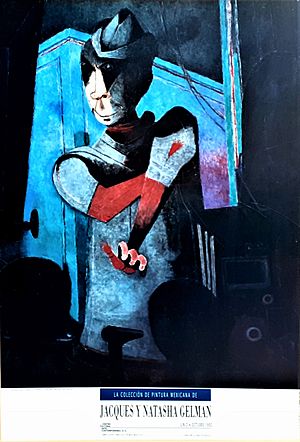
In 1956, Cantinflas made his American movie debut in Around the World in 80 Days. This movie earned him a Golden Globe award for Best Actor in a musical or comedy. Variety magazine said in 1956 that his Chaplin-like style greatly helped the movie's success. The film made a lot of money. While David Niven was the main star in English-speaking countries, Cantinflas was the main star everywhere else. Because of this film, Cantinflas became the highest-paid actor in the world!
Moreno's second Hollywood movie, Pepe, tried to be as successful as his first. Many famous stars like Frank Sinatra and Judy Garland made short appearances in the film. However, Cantinflas' humor, which was so tied to the Spanish language, didn't translate well for American audiences. The movie was not very successful. He still received another Golden Globe nomination for his role. Later, in 1992, Moreno said that the language barrier was the biggest reason he didn't become a huge star in the United States.
After returning to Mexico, Cantinflas starred in the funny drama El bolero de Raquel (1957). This was the first Cantinflas film that Columbia Pictures distributed in the United States. More Cantinflas films followed, including El analfabeto (1961), El padrecito (1963), and Su excelencia (1967). After Su excelencia, Cantinflas started appearing in comedies directed by Miguel M. Delgado. These films were made by his own company, "Cantinflas Films," and continued until El Barrendero in 1982.
Like Charlie Chaplin, Cantinflas used his comedy to comment on society. He played el pelado, a poor, everyday person who hoped to succeed. Cantinflas admired Chaplin's early films and ideas. For example, his movie El Circo was similar to Chaplin's silent film The Circus. Also, Si yo fuera diputado ("If I Were a Congressman") had many similarities to Chaplin's 1940 film, The Great Dictator. Even today, Cantinflas' films still make money for Columbia Pictures. In 2000, Columbia reported earning about $4 million from distributing his films in other countries.
Death and Legacy
Cantinflas was a smoker for many years and died of lung cancer on April 20, 1993, in Mexico City. Thousands of people came to his funeral, even though it was a rainy day. The ceremony was a big national event that lasted three days. Many world leaders and the United States Senate honored him with a moment of silence. His ashes are buried in the family crypt at the Panteón Español ("Spanish Cemetery") in Mexico City.
After his death, there was a long legal fight over who owned the rights to his 34 films. This battle lasted 20 years between his son, Mario Moreno Ivanova, and his nephew, Eduardo Moreno Laparade. In 2014, Eduardo Moreno Laparade won the rights to 39 films and the Cantinflas name in the Mexican Supreme Court.
There was also another legal battle between Columbia Pictures and Moreno Ivanova over these films. Columbia said they bought the rights to 34 films many years ago. Moreno Ivanova wanted the rights to stay with him and with Mexico, seeing them as a national treasure. In 2001, the eight-year battle ended with Columbia keeping ownership of the 34 films.
Cultural Impact
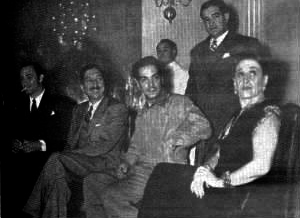
One reason people loved Cantinflas was his funny way of using language in his movies. His characters would start a normal conversation but then make it so complicated that no one understood what they were saying. The Cantinflas character was especially good at confusing people when he owed money, was trying to impress a girl, or trying to get out of trouble with the police. He would even make authorities look silly without them realizing it!
This way of talking became known as Cantinflear. It became common for Spanish speakers to say "¡estás cantinfleando!" (meaning "you're pulling a 'Cantinflas!'") when someone was hard to understand. The official Spanish dictionary, the Real Academia Española, even added the verb cantinflear and the words cantinflas and cantinflada in 1992.
In art, Mexican artists like Rufino Tamayo and Diego Rivera painted Cantinflas. They saw him as a symbol of the everyday Mexican person.
Cantinflas' style and the messages in his films influenced many theater groups that spread the ideas of the Chicano Movement in the United States during the 1960s and 1970s. The most important of these was El Teatro Campesino. Cantinflas' use of social themes and his unique style are seen as an early example for Chicano theater.
An animated cartoon series called the Cantinflas Show was made in 1972. It starred an animated Cantinflas and was made for children to be educational. In the first version, Cantinflas taught children by meeting famous people like Chopin and Albert Einstein. He also taught about important things like water and oil. In a later version, his character was called "Little Amigo." This show taught children about many topics, from the start of soccer to why we have the International Date Line.
Even though Cantinflas never became as famous in the United States as he was in Mexico, he was honored with a star on the Hollywood Walk of Fame. He also received two Golden Globe nominations (winning one) for best actor and a Lifetime Achievement Award from the Mexican Academy of Film. His handprints are also in the Paseo de las Luminarias in Mexico.
The Mario Moreno "Cantinflas" Award is given out every year to entertainers. It honors those who "represent the Latino community with the same humor and distinction as the legendary Mario Moreno 'Cantinflas'" and who use their influence to help those in need.
On August 12, 2018, Google Doodle honored Cantinflas on what would have been his 107th birthday.
Movies About Him
Mario Moreno's life is the subject of the movie Cantinflas (2014), directed by Sebastian del Amo. The film shows a young Mario Moreno trying to become a respected actor. It also features the American film producer Mike Todd, who was working on his famous movie Around the World in 80 Days. The movie focuses on Moreno's personal life and how Todd's film was made.
Filmography
| Cinema of the United States | ||||
| Year | Director | Title | Role | Notes |
|---|---|---|---|---|
| 1956 | Michael Anderson | Around the World in 80 Days | Passepartout | |
| 1960 | George Sidney | Pepe | Pepe | |
| 1969 | Norman Foster | The Great *** War | General Marcos | |
| Cinema of Mexico | ||||
| Year | Director | Title | Role | Notes |
|---|---|---|---|---|
| 1937 | Miguel Contreras Torres | Don't Fool Yourself, Dear | Canti | |
| 1937 | Arcady Boytler | Such Is My Country | El Tejón | |
| 1937 | Arcady Boytler | Heads or Tails | Polito Sol | |
| 1939 | Chano Urueta | The Sign of Death | Cantinflas | |
| 1939 | Fernando Rivera | Siempre listo en las tinieblas | Chencho Albondigon | Short |
| 1939 | Fernando Rivera | Jengibre contra Dinamita | Cantinflas | Short |
| 1940 | Juan Bustillo Oro | You're Missing the Point | Cantinflas / "Leonardo del Paso" | |
| 1940 | Carlos Toussaint | Cantinflas y su prima | Cantinflas | Short |
| 1940 | Fernando Rivera | Cantinflas ruletero | Cantinflas | Short |
| 1940 | Fernando Rivera | Cantinflas boxeador | Cantinflas | Short |
| 1941 | Alejandro Galindo | Neither Blood Nor Sand | El Chato / Manuel Márquez "Manolete" | |
| 1941 | Miguel M. Delgado | The Unknown Policeman | Badge Number 777 | |
| 1942 | Carlos Villatoro | Carnival in the Tropics | Himself | Cameo |
| 1942 | Miguel M. Delgado | The Three Musketeers | Cantinflas / D'Artagnan | |
| 1943 | Miguel M. Delgado | The Circus | Cantinflas | |
| 1943 | Miguel M. Delgado | Romeo and Juliet | Romeo de Montesco / Abelardo Del Monte | |
| 1944 | Miguel M. Delgado | Gran Hotel | Cantinflas | |
| 1945 | Miguel M. Delgado | A Day with the Devil | Juan Pérez | |
| 1946 | Miguel M. Delgado | I Am a Fugitive | Cantinflas | |
| 1947 | Miguel M. Delgado | Fly Away, Young Man! | Cantinflas | |
| 1948 | Miguel M. Delgado | The Genius | Cantinflas | |
| 1949 | Miguel M. Delgado | The Magician | Cantinflas | |
| 1950 | Miguel M. Delgado | The Doorman | El Portero | |
| 1951 | Miguel M. Delgado | El Siete Machos | Margarito | |
| 1952 | Miguel M. Delgado | If I Were a Congressman | Cantinflas | |
| 1952 | Miguel M. Delgado | The Atomic Fireman | Agente 777 | |
| 1953 | Raúl Medina | Bella, la salvaje | ||
| 1953 | Miguel M. Delgado | The Photographer | Cantinflas | |
| 1954 | Miguel M. Delgado | A Tailored Gentleman | Cantinflas | |
| 1955 | Miguel M. Delgado | Drop the Curtain | Cantinflas | |
| 1957 | Miguel M. Delgado | El bolero de Raquel | El Bolero | |
| 1958 | Tulio Demicheli | Ama a tu prójimo | Luis | |
| 1959 | Miguel M. Delgado | Sube y baja | El falso Jorge Maciel | |
| 1961 | Miguel M. Delgado | The Illiterate One | Inocencio Prieto y Calvo | |
| 1962 | Miguel M. Delgado | The Extra | Rogaciano | |
| 1963 | Miguel M. Delgado | Immediate Delivery | Feliciano Calloso | |
| 1964 | Miguel M. Delgado | El padrecito | Sebastián | |
| 1965 | Miguel M. Delgado | El señor doctor | Salvador Medina | |
| 1967 | Miguel M. Delgado | Su excelencia | Lopitos | |
| 1968 | Miguel M. Delgado | Por mis pistolas | Fidencio Barrenillo | |
| 1969 | Miguel M. Delgado | Un Quijote sin mancha | Justo Leal, Aventado | |
| 1971 | Miguel M. Delgado | El profe | Sócrates García | |
| 1973 | Roberto Gavaldón | Don Quijote cabalga de nuevo | Sancho Panza | |
| 1973 | Miguel M. Delgado | Conserje en condominio | Úrsulo | |
| 1976 | Miguel M. Delgado | El ministro y yo | Mateo Melgarejo | |
| 1978 | Miguel M. Delgado | El patrullero 777 | Diógenes Bravo | |
| 1982 | Miguel M. Delgado | El barrendero | Napoleón | |
Awards and Nominations
| Year | Award | Category | Film | Outcome |
|---|---|---|---|---|
| 1952 | Ariel Awards | Special Ariel | Won | |
| 1987 | Golden Ariel | Won | ||
| 1957 | Golden Globe Awards | Best Performance by an Actor in a Motion Picture – Comedy or Musical |
Around the World in 80 Days | Won |
| 1961 | Pepe | Nominated | ||
| 1961 | Laurel Awards | Top Male Comedy Performance | Nominated | |
| 1962 | Menorah Awards | Best Comic Actor | El analfabeto | Won |
See Also
 In Spanish: Cantinflas para niños
In Spanish: Cantinflas para niños
- Mononymous person
- Chespirito



